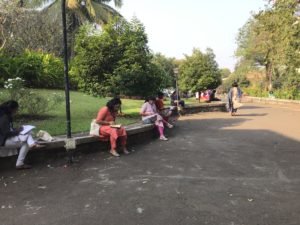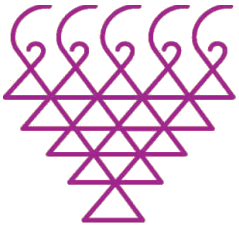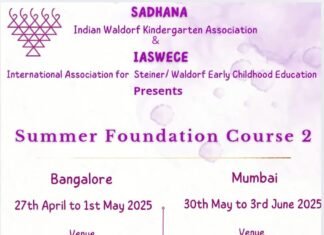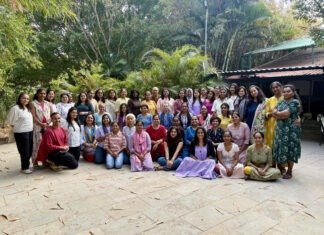The 4th National Waldorf Kindergarten Conference took place in Mumbai from January 23rd to 25th 2020
This year Sadhana looked forward to having Ms Silvia Jensen as our guide into the world of Elemental beings for both the train the trainer programme as well as being the keynote speaker at the conference held In January 2020.
As the topic was of a super sensible nature that had not been touched before at any other Kindergarten conference, almost 100 Early childhood facilitators from both Waldorf and Waldorf inspired schools, eagerly came from different cities of India, to attend.
While Sylvia conducted 5 lectures on this magical yet very pertinent topic, The 5 Sadhana core group members, Sucheta Garud, Apeksha Chowdhary, Preeti Misra, Latha Madhusudhan and Jyotsna Mandana conducted workshops on the 5 elements in relation to various aspects of work in the Kindergarten. Ms Dilnawaz Bana conducted 2 lectures of the elemental beings in relation to the 12 senses. Ms Vidhya Iyer of Tridha school conducted as session as well.
Ms Silvia Jensen
Silvia conducted a total of 5 lectures of 1.5 hrs each on Elemental Beings using Rudolph Steiner’s lectures GA 230, chapter 7, 8 and 9 as her basis. She brought in singing in rounds with adults and two circle time songs pertinent to the topic. Reference material (Marco Pogacnik and Verena Stahl) any more please add

Lecture 1-23.1.2020 Introduction to Elemental beings -Beings of the Mineral Realm
Through a series of Poems taken by well known poets, as well as reflective observation exercises, based on our own sense perception, Silvia gently woke us into the intangible, mysterious realm of nature beings, over two and a half days.
It brought us into a space of understanding that only if we humans make the effort to connect with nature ,will the Angels and Elemental beings reach out to connect with us. It made us aware of the different elements at play when watching a sunrise or observing a plant outside our window and how little we really “see “when we are “looking”.
She laid emphasis on the fact that to enter this realm, one has to be purely objective in thought (ie develop the capacity to see things for what they are) and lead a highly moral life. (ie Strive to think good thoughts, be equanimous in feeling and do good deeds for the Earth) Half an hour of each of Silvias session were dedicated to observing and expressing them either through art or movement.
Silvia spoke of the genesis of Gnomes from primordial cosmic forces that are bound to the formation of the earth. She elicited from us the qualities of the mineral world and how they reflect in the qualities of the beings of gnomes who are bound to the Earth in their existence and survival in the most quintessential manner.
They are pure sensory beings who know the essence of any stone rock seed or ore. She connected the human world to the Gnomes based on the fact that these beings have no moral code of their own and base their task on the moral code and behaviour of human beings. She spoke on how Gnomes are responsible for pushing seeds out of the ground and receiving messages of the universe by the other elemental beings through dead plants.
Silvia spoke of their likes and dislikes and the consequence of these beings if they bound to Humans earthly thoughts and deeds. She then laid out for us the task of the gnomes and drew parallels to the Indian God of the mineral world Prithvi.
Lecture 2-24.1.2020 (Morning) Realm of the Water beings
Silvia covered the Realm of the Undines and drew parallels to Varuna the lord of Water. She spoke of their genesis from the eternal cosmic quality of continual transformation and at an earthly level are created and sustained on dead and decaying matter.
Their qualities being more of a dream like nature ,who create the tangible reality of the forms of plants just by dreaming them. They work strongly with the elements of water in combination with air.
Silvia spoke of their qualities what they offer to the plant along their likes and dislikes and the earthly consequences they face if they are bound to Human beings earth bound deeds and thoughts
Lecture 3-24.1.2020 (Evening) Realm of the Air beings
Silvia covered the topic of the uplifting,omnipresent beings of the air – The Sylphs and drew parallels to the Indian god of the air Vayu. She spoke extensively on how the Sylphs due to their very nature cannot be trapped to the earth in any manner.

Sylphs being bearers and preservers of Light Ether who read and imprint the messages in the air from the cosmic light. They provide the blueprint of the ideal form of the plant created in the cosmos. She spoke of their genesis how they feel themselves and where and when they are most active
Lecture 4 25.1.2020 (Morning) Realm of the Warmth beings
Silvia covered the genesis and qualities of Salamanders by eliciting responses from us on the quality of fire It was fascinating to listen to her speak on the how they connect with the earthly realm through motion of butterflies and bees.
She spoke on the conventional understanding of the process of pollination and how the phenomenon actually occurs as well as the role of the butterflies and bees in this process. There was a palpable silence in the room after Silvia spoke of butterflies and bees being the carriers of cosmic love and warmth and that butterflies carry cosmic memories imprinted on their wings and how they are the most spiritualised creatures on earth.
Lecture 5 – 25.1.2020 Caring for Elemental beings
Silvia spoke ardently about how Technology is developing faster than the human body and how as humans we are unable to cope. She gave us various ideas on how we as humans can nourish and sustain these beings by making changes within us and the environments around us.
Dilnawaz Bana ( 23.1.2020 24.1.2020 )the 12 senses and elements and their beings
Dilnawaz started her session with speaking of the importance of the spoken word and went on to describe how senses are the doorways to perception. One experiences oneself and the world through senses She spoke of how the creative warmth of the universe was encapsulated in the sound AOM. In the Rig Veda its called Parahpashyate – Madhyam – Naykeri. Parampashyate -meaning -warm light of illumination. Madhyam -Meaning balancing in the middle and Naykeri meaning its distribution on earth.
AOM represents
A the creative force (Brahma)
O the balances or preserves (Vishnu)
M the completion of this process (Shiva)
Dilnawaz divide the senses into two different categories one which we experience for ourselves and the other is how we transfer the first set into interacting with the world.
Earth -Life sense-Is created through nurturing the physical in child inwardly (ie nutrition and general sense of well being ,which further develops into a sense of freedom in thought.(sense for the world)
Air -Movement sense – If children are nurtured to move in space in the right manner develops into a healthy sense of speech( sense for the world)
Water – Sense of Balance – In the Vasthu Shastra this sense is just as responsible for holding a plant upright just as much as it holds a baby to stand and feel himself in space. If this sense is nurtured then we teach a child to be responsible for his own equanimity.(Worldly sense)
Fire – Sense of Touch – Warmth is carried through touch If this sense is nourished in the right manner
A child grows into an adult with a sense of holy striving for the world
Day 2 Lecture 2
Dilnawaz covered in great detail the quality of the 12 senses in relation to the qualities of each sign of the zodiac along with its equivalent in the Hindu astrological chart. She gave us the sound of each sun sign in English as well as Hindi
Sucheta Garud How to connect with the five elements (25.1.2020- 1.5 hrs)

To explore ways of synchronising our bodily energies with the infinite pool of Universal Energy, we need to connect with in order to expand and harmonise our relationship with nature
The 5 elements. The Five Subtle Elements – Earth, Fire, Water, Air and Ether or Space form the basis for all things found in the material creation, from a grain of sand to the complex physiology of every human being.
The elements or the PanchaMahaBhutas as the Vedas describe them are the fundamental building blocks of the Universe. These 5 elements are the essence of the entire world, both within you and outside, so it is more than essential to connect with them for tapping into the powers of the Universe.
It might seem rather surprising but the 5 elements influence behaviour, emotions, and overall health. Balancing these elements in just the right way is the key to a happy and healthy life. If we take some time to understand the elements and relate to them, we can use them to stay in balance physically, spiritually, emotionally and mentally.
By understanding the positive and negative aspects of each element, we can tune our minds to use each element in the most effective way. The first rule of thumb is that we cannot dominate the Elements. Instead, we have to surrender to the elements and respect them.
The more we comprehend the PanchaMaha Bhutas, the more we will understand and relate to the universe. The best way to get to grips with these 5 elements is to figure out their basic characteristics and how they relate to physical attributes. Here is a simple way to begin your journey of understanding the universe from an element based viewpoint
Ms Preeti Misra ( 24th and 25th January – each session 1.5 hours)
Session 1 – Planning of inner and outer spaces
The interactive session included practical inputs on how one can create a nourishing well balanced environment for both the children and the teacher. We explored various ideas on how the elements, their qualities and essence, and what gifts they offer to us can be weaved artistically into the physical space where children play both indoors and outdoors.
Session 2 -Nature Table
The session was a journey looking into nature , understanding and deepening ones connect to nature. We drew inspirations from nature as the archetypal Artist and how we need to keep the artist inside us alive and enliven our sacred inner space and allow the artist in us to express what lies within through the nature table ie a visible expression.
We also looked at how we can balance all the elements on the nature tableThe session was warm and interactive with participants finding answers to colleagues queries
Ms Latha Madhusudhan ( 24th January ) 1.5hrs
Creative Expressions and the five elements
We started with discussing the five elements and the colours that each element can be represented. We used pastels to explore each element through colours. We then walked through nature observing few trees and plants discussing and observing the work of the elemental beings in nature. All expressed the same through poetry, drawing s or verses. We ended the session with gratitude to the elements and the elemental beings.
Ms Apeksha Chowdhary(24th and 25th January -each session 1.5 hrs)
Playful Exploration of the four Elements
Through play we encourage children’s interest in the natural world. A number of activities, games and toys are used that involves the four elements earth,water,fire and air. Through play with the four elements we also introduce them to very basic scientific principles such as gravity, momentum and light refraction in a fun and creative manner.
While the elements like water and air can be played directly , earth and fire can only be played indirectly. The children are naturally and instinctively drawn to play with all the elements and given a chance can play with them for hours together.
The very young children may play very simply by splashing water in the puddles or jumping in the puddles and slowly the play starts getting complicated, now they throw the stone in the water and see how it splashes out or making a paper boat and sailing it or making a path for the flowing water like a small canal.
The earth element can be experienced through sand play, skipping, playing with the ball and everything spherical,gives an experience of the gravity. The air is experienced through blowing a feather in the air,or whistling and blowing the soap bubbles.
Whereas fire element is experienced through a lamp on the story table, during cooking activities, beeswax and most of all thru love and warmth that they receive from the teachers. We ended our session with clay modelling as this activity has all the four elements.
Ms Vidya Iyer- Story Telling 24th and 25th January
Mantle of stories and it’s elements in the kindergarten.
Day 1-Session 1-24.1.2020
We began with a small introduction of the participants. A few recently connected to Waldorf kindergarten and few were totally new. An insight and brief to early years and Steiner’s fourfold and three fold guidelines was shared. Why stories and how do we connect With stories in kindergarten for different age groups were discussed.
I narrated the “birthday story “in kindergarten.. and we discussed what element we can incorporate for different age groups while narrating a birthday story. We also discussed How we move on from simple lullabies to nature stories, Repetitive stories and Fairy tales, keeping in mind different age groups. We covered the importance of speech, breath, gestures and tone as elements while narrating a story.
We divided the group into 4 and worked how to work with images for different age groups and lastly Did puppetry movement for sweet porridge story …
Day 2-session 225.1.2020.
Participants collected elements from nature and we worked in groups for four simple stories for 3/4 year olds .We touched on elements briefly.
Jyotsna Mandana – Working with the 5 elements on the morning circle. (24.1.2020 -25.1 20200) 1.5 hrs each session
Day 1 24.1.2020 -session 1
We started the session with a couple of morning circle songs which had the elements in them. A song was given to the participants which had creatures from different realms and they were divided into groups to create movements for the verses. In the presentations each group was given feedback by their colleagueson their movements to see how they may be improved.
Archetypal gestures of creatures of different elements was covered too as well as the need for it in the Kindergarten. As a filler a game was played where each participant had to act out the form of the element /or creature they were given on a slip of paper.
Each person was given the home work to create a song /verse with whatever word they had received -be it element or creature. We then explored what is the Fire /water Air and Earth element of the circle inwardly and outwardly and its effect on the children in the Kindergarten.
Eg water – flow in the morning circle, connectedness of songs flow of gestures its effect on the child’s ether body(Physical and memory)
Day 2 25.1.2020 Session 2
After the previous day was reviewed we discussed the need for Truth (Through archetypal gestures), Love (Through reverential gestures) and Beauty (In movement and structure of the morning circle ) in the circle time to be demonstrated on part of the adult and how could this be achieved in a city far from nature.
The teachers were taught some simple voice exercises using the vowel sounds to improve tone and pitch and then we went into what the mood of the 5th is in theory and practice very briefly. The overall feedback was positive and the need was felt by the whole group to go deeper into the mood of the 5th in future.
The whole conference was received very well by all the participants both new and experienced . Many folk felt extremely humbled by the experience and felt they received a new reverence for nature through the lectures and workshops that supported the theme.
Evenings were spent either bonding with colleagues from all parts of India ,sharing songs ,games and challenges as well. One of the highlights of the conference was a bonfire to celebrate the harvest season ,where colleagues sang their songs and danced together.
















